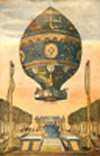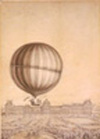

 |
 |
|
The inflation of the first hydrogen balloon, the Charlière, August 1783.
The first public balloon ascent, June 1783. The first passengers ascend into the air, September 19, 1783, in Annonay, France. 
The first balloon flight with passengers -a cock, a sheet, and a sheep - on September 19, 1783. 
The
first free ascent of a hot-air balloon with human passengers— 
Charles' hydrogen balloon landing at Gonesse. Frightened peasants destroyed the balloon. 
Blanchard's
balloon flying over France after completing 
Blanchard's
balloon flying over France after completing |
Early Balloon Flight in EuropeThe first public demonstration of a lighter-than-air machine took place on June 4, 1783, in Annonay, France, when Joseph and Jacques Montgolfier, two brothers who owned a paper mill, sent up an unmanned hot-air balloon. They had observed that smoke tended to rise and that paper bags placed over a fire expanded and also rose, pushed upward by the hot air. They concluded that if they could only capture what they thought was a unique gas inside an enclosed lightweight bag, this container or bag would rise from the ground. Etienne Montgolfier carried out the first experiment at Avignon, France, in September 1782, proving their theory to be sound. They had rediscovered the theory of buoyancy, which the Greek mathematician and philosopher Archimedes had discovered in the second century B.C.E. Their original test balloon was made of paper and linen and opened at the bottom. When flaming paper was held near the opening, the bag, called a 'balon', slowly expanded with the hot air and floated upward.
The brothers tested balloons ranging in size from 40 cubic feet (1.1 cubic meters) to 650 cubic feet (18.4 cubic meters). The balloons rose from 90 feet (27 meters) to 600 feet (183 meters) in the air. After concluding that their experiment worked, they finally built a large cloth and paper balloon 10 meters in diameter and tested it on June 4, 1783, in the marketplace at Annonay. The balloon, from then on called a Montgolfiere, rose about 2,000 meters (6,562 feet) into the air. After their success, the brothers went to Paris and built another larger balloon. On September 19, 1783, in Versailles, the Montgolfiers flew the first passengers in a basket suspended below a hot-air balloon—a sheep, a rooster, and a duck. The flight, which lasted eight minutes, took place in front of Louis XVI, Marie Antoinette, and the French court, as well as a crowd of about 130,000. The balloon flew nearly 2 miles (3.2 kilometers) before returning the occupants safely to earth.
The next major milestone occurred on October 15, 1783, when the brothers constructed a hot-air balloon that, at the end of a tether, rose 84 feet (25 meters) into the air with its first human passengers, Jean-François PilΓtre de Rozier, perhaps accompanied by the Marquis d'Arlandes. (Authorities differ on whether the marquis went on this first flight.) With a capacity of 60,000 cubic feet, PilΓtre de Rozier stayed aloft for almost four minutes. A short while later, on November 21, 1783, the first confirmed aeronauts, de Rozier and d'Arlandes, made a free ascent in a balloon and flew from the center of Paris to the suburbs, about 5.5 miles (9 kilometers) in some 25 minutes. On January 19, 1784, a huge hot-air balloon built by the Montgolfiers carried a total of seven passengers to a height of 3,000 feet (914 meters) over the city of Lyons.
At the time, the Montgolfiers believed they had discovered a new gas, which they called 'Montgolfier gas' that was lighter than air and caused the inflated balloons to rise. In fact, the gas was merely air, which became more buoyant as it was heated. The balloon rose because the contained air was lighter and less dense than the surrounding atmosphere, which pushed against the bottom of the balloon.
Once human passengers had demonstrated that they could safely travel by balloon, balloon flight was firmly established. However, the limitation of using air was soon discovered because, as the air in the balloon cooled, the balloon was forced to descend. If a fire was kept burning to warm the air constantly, sparks were likely to reach the bag and set it afire. Hydrogen overcame this obstacle. Jacques Alexandre César Charles, member of the French Academy of Science, successfully tested a new type of balloon in which hydrogen replaced air in a silk bag that had been treated with an elastic gum so that hydrogen could not readily pass through it. On August 27, 1783, Charles launched the first balloon inflated with hydrogen gas in Paris. Unlike the Montgolfier balloon, this hydrogen-inflated balloon was closed to contain the gas. The sphere, which measured 13 feet (4 meters) in diameter, ascended from the Place des Victories in Paris to a height of nearly 3,000 feet (914 meters) and came down some 15 miles (24 kilometers) away where terrified peasants attacked and destroyed it. Although highly flammable, hydrogen soon replaced air as the buoyant gas for balloons. Charles built a new balloon that he named La Charlière and, on December 1, 1783, successfully took off from the gardens of the Tuileries in Paris before a crowd of 400,000 people, carrying Charles and an assistant, M.N. Robert. La Charlière covered 27 miles (43 kilometers) before landing safely at Nesle. This balloon was much like a modern balloon. The basket in which they traveled hung from a net that covered the entire balloon and thus distributed the weight evenly. The bag opened at the bottom and had a valve at the top. Stones were used for ballast, and a barometer and a thermometer were carried to measure the pressure and temperature of the air, making this the first scientific balloon flight.
Ballooning continued to grow in popularity. On January 7, 1785 Jean-Pierre Francois Blanchard and John Jeffries, an American doctor, made the first trip across the English Channel in a hydrogen balloon in a trip that took 2-1/2 hours. During this trip, the balloon unexpectedly lost gas and almost fell into the English Channel. Only by throwing all of their ballast and most of their clothing into the Channel did they manage to stay in the air. The two aeronauts were forced to heave all cargo overboard except the package of the first international airmail, delivered successfully upon their safe landing in the Felmores Forest, France.
Pilâtre de Rozier, who had made the first balloon ascent, was also the first victim of balloon travel. He was killed on June 15, 1785, when his balloon, filled with a combination of hydrogen and hot air, exploded. After Blanchard had crossed the English Channel with Dr. Jeffries, he continued his balloon exhibitions. He lost his life in a balloon accident in 1809, but his widow, Madéleine-Sophie Blanchard, carried on the family tradition, becoming the first female aeronaut. Her luck ended in Paris on July 7, 1819. Her balloon caught fire from the lights and fireworks that she was setting off and, although she brought the balloon down onto a rooftop, a gust of wind blew her off the roof onto the street. She broke her neck and died in front of a crowd of horrified onlookers. --Judy Rumerman Bibliography: Ege, Lennart A. T. Balloons and Airships. Editor of the English edition, Kenneth Munson from translation by Erik Hildesheim. New York: Macmillan. 1974 Kirschner, Edwin J. Aerospace Balloons – From Montgolfiere to Space. Fallbrook, Calif.: Aero Publishers, Inc. 1985. Macmillan, Norman. Great Flights and Air Adventures, From Balloons to Spacecraft. London: G. Bell, 1964. Rolt, L.T.C. The Aeronauts: A History of Ballooning - 1783-1903. New York: Walker and Company, 1966.
|